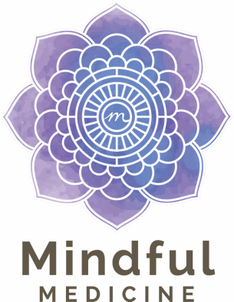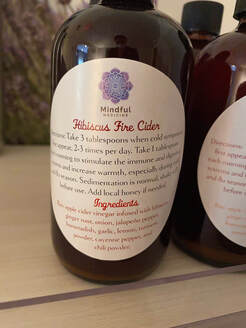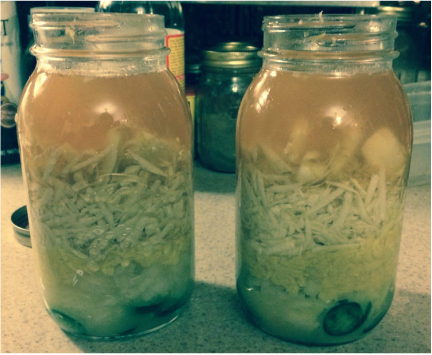|
I have been making fire cider for almost 10 years now, and it is a must have immune tonic in my house. Fire cider is especially helpful during the fall and winter months when the immune system is typically more susceptible to illness. What I love about this spicy elixir, is that the ingredients are accessible to anyone, you can get most of them at your grocery store right now. While I am always happy to share my fire cider with others, you do not need to be an herbalist to prepare fire cider yourself! The ingredients of fire cider are very pungent and spicy by nature and are soaked in apple cider vinegar for 4 weeks for maximum potency (see below for our current recipe). Once it is prepared and the fire cider is strained, it is best to take a tablespoon every morning during the fall and winter months. You can also add this fiery mixture to your next salad dressing or toss with vegetables for a flavorful, spicy kick to your meal. Fire cider will help to promote your circulation and warm you up, clear up your sinuses and any phlegm congestion, stimulate your digestion, and has several antimicrobial ingredients. When you first notice a cold coming on, such as symptoms of a runny nose, sore throat, nasal congestion, etc, take 2-3 tablespoons, 3 times a day. If symptoms progress, come see me for a custom herbal formula and acupuncture to help improve your body's function. As a doctor of Chinese medicine, some of my major philosophies for good health are relevant for my love of fire cider. First, food and water are the best medicines. What we put into our bodies every day has the most profound effect on overall health and longevity, and should not be overlooked. There is no number of acupuncture needles or herbs that replaces the need for having a balanced diet and optimal water, full of nutrients and antioxidants and free from artificial chemicals and pesticides. This fire cider recipe is easy to make and gives you a connection to a food-based medicinal elixir that has numerous health promoting properties. As an herbalist, I am always thinking about flavors of the herbs and how they are combined for a therapeutic direction in the body. The pungent flavor increases the circulation of blood and stimulates our wei qi, which is our protective vital force, at the surface of the body and organs. The pungent flavor also greatly benefits the metal organs, which are the lung and large intestine. As a result of ingesting the pungent flavor, our blood circulation is stimulated and our system will be better prepared to handle pathogenic qi. The apple cider vinegar has a sour flavor, which is astringing, balances the very strong pungent flavor, and benefits the wood organs, which are the liver and gallbladder. A little honey can also be added to bring in the sweet flavor, making it even more balanced and beneficial to the earth organs, which are the spleen and stomach. Our last several batches have had the bonus ingredient of hibiscus flower, which is also slightly astringent and has an affinity for the heart. Even though the dominant flavor of fire cider is pungent, it is balanced with the sweet and sour flavors, which is the sign of a great remedy! I hope you all consider trying our Hibiscus Fire Cider and consider making this useful medicinal elixir for yourself. We do have some in stock at Mindful Medicine for $14 a bottle, if you want to give it a try first. Here is the recipe we have been using, on a much smaller scale for you to make at home. Feel free to get creative with other herbs, spices, and foods you have around your kitchen for your own unique batch and flavors. Let us know how you like it, and happy medicine making!
Mindful Medicine’s Hibiscus Fire Cider Our recipe is inspired by the herbalist, Rosemary Gladstar Ingredients:
1. Prepare your ingredients and place them in a quart-sized glass jar. Double or triple the recipe for multiple fire cider lovers in a household. Be prepared for a powerful sinus blast when grating fresh horseradish! 2. Pour the apple cider vinegar into the jar and cover the ingredients completely. 3. Put parchment under the metal lid or use a plastic lid. Shake the jar well. 4. Store in a dark, cool place for 4 weeks. Shake the jar every day. 5. After 4 weeks, use cheesecloth or an herb press strain out the pulp and the fire cider into a clean jar. Squeeze as much liquid out of the vegetable/herb pulp as possible. 6. Stir in honey to taste. (We do not bottle ours with honey, so feel free to add if you want a little sweetness!) Enjoy!
0 Comments
Acupuncture, the Human Nervous System, and Pain Management by Dr. Alexander Achenza, L.Ac., DACM11/6/2021 Acupuncture is over 2,000 years old as a form of medicine and has countless ties to philosophical, cultural, spiritual, and scientific evolution throughout human history and civilization. It has developed all over the world to become what it is now, as a whole health care system utilizing both acupuncture and herbal medicine. Acupuncture and TCM, or Traditional Chinese Medicine, are a holistic system of medicine, which promotes and facilitates the body's innate ability to heal itself and keep within the parameters of homeostasis, or balance and harmony. This blog will look into the treatment of pain and conditions involving physical tension and discomfort in the body. We will cover both an esoteric perspective of how pain can be treated with acupuncture as well as a more modern view of the treatments using the terms and parallels of medical science. To begin, let's talk about a concept in TCM called Qi. Qi can be described as the vitality of the body and all of the systems in the body that bring about health and wellness. There is also Qi in nature, all things that exist in this universe have some form of Qi that flows throughout it, within it , and into all things it touches. There are countless forms and manifestations of Qi in this universe, most of which we have not yet discovered and do not yet understand, much like science. For human beings, Qi is what protects the physical body from harm in the environment. The body has multiple forms of Qi to carry out different tasks, which have different purposes to bring about homeostasis. Different organs in the body are correlated with different types of Qi, all with different personalities and characteristics of their own. For example, on the topic of immunity and how Qi protects the body, Wei Qi. Wei Qi is the vitality of the body's immune system and is associated with the lungs. If you were to picture your body like a castle, and an illness trying to break into the castle, the Wei qi is the moat around the structure itself. Wei Qi acts as the first line of defense for our immunity and to protect us from external pathogens. This can also be seen in the parallel between modern anatomy and physiology with TCM in that the lung, and breathing, takes in air from the environment into our bodies. Aside from just this one example of Wei qi, there are many other organs and with these organs we have pathways of Qi called meridians or channels. The main channels of the body consist of fourteen pathways which are all associated with different organs, all with different correlations to aspects of health. The channels are like main roads for the vitality of the body to flow through and when there is a traffic jam in one of these main roads, we can develop a variety of conditions over time. One very common condition we see as a result of one of these traffic jams of Qi is pain. The classical way to describe this occurrence in TCM is called Qi stagnation, or obstruction of Qi. It is when the vital force of the body which ensures proper health and wellness is not able to function how it should. Over time, if there is some sort of blockage or stasis of Qi in a channel, it will continue to backup and create issues in the health of the body which will have symptoms manifest, such as pain. Examples of things in life that can cause Qi imbalances and stagnation are things like physical injury, emotional stress and trauma, improper exercise or lack thereof, overworking and overextension, and poor dietary choices. Basically, anything that brings the body or your life out of a state of balance will also be bringing the vitality of your body and the associated Qi out of balance as well. Acupuncture is a comprehensive process which is able to identify these imbalances of Qi and possible stagnations in the channels. The intake of an acupuncture treatment is very in depth and thorough because it addresses exactly how to bring the body and Qi back to a state of equilibrium. Different acupuncture points along the channels have different functions and characteristics to do this. For example, certain points are used to build up and nourish Qi if there is a Qi deficiency causing an illness, and others are used to promote the movement of Qi along a channel for unblocking stagnation. This example is only mentioned to illustrate the diversity of functions with different acupuncture points. By using acupuncture points in a treatment to unblock Qi stagnation which is associated with your pain, we can treat the condition and greatly improve how you feel. Points which move qi are among the most numerous in the body and are located in all of the major fourteen channels associated with the major organs in TCM. These channels run through different areas of the body and stretch out to the arms and legs as well. Therefore, pain located in any given area of the body can be associated with Qi stagnation in the channel that is located there.
It is also possible for pain to be located along a portion of a channel, but the stagnation to be located in another area, or for there to be a point which is very strongly used to move Qi in a different place than where you may be experiencing the pain itself. For an example, let's talk about the large intestine channel and how it can treat headaches. The large intestine channel spans from the index finger to the face, by the side of your nose. Let's say that you have a headache one day and come in to Mindful Medicine to take care of it. One of the major points to move Qi, used to treat pain associated with Qi stagnation and headaches is the fourth point on this channel. It is a very powerful point and is one of the more common points used by acupuncturists because of its ability to instantly start Qi movement. Now let's for a moment flip the narrative here from esoteric and philosophical to an evidence based perspective of medical science and neuroscience. The fourth point on the large intestine channel (LI4) is located on the back of the hand, between the thumb and index finger in the belly of the muscle. LI4 is about the size of a dime in its diameter and can be used to treat conditions of the face, head, teeth, and neck because the pathway of the channel flows through those areas. Looking at the neuroscience based mechanisms and actions of this point's abilities involves a basic understanding of the anatomy of the nervous system. Our nerves branch out from our spinal cord and form into large clusters called a plexus. From a plexus major nerves branch even further to our limbs and eventually branch again to form smaller nerve fibers the more distal from the spine they become. Much like how a tree forms branches that are thicker when they are closer to the main trunk, and thinner as they get further away. LI4, being located on the dorsal aspect (back of) the hand has the ability to stimulate the dorsal branches of the radial nerve as well as the palmar-digital branch of the median nerve depending on the depth of the needle. Both of these aforementioned nerves are branched out from the arm and forearm, and trace back to a cluster of nerves close to the spinal cord called the brachial plexus. When the point on the hand is stimulated, it causes the rest of the associated nerve path to also receive some level of stimulation. It is easy to see the parallel and connection between the western nervous system and the eastern meridians of acupuncture when picturing this happening. LI4 specifically is shown to affect a type of nerve fiber called afferent delta fibers which carry nerve impulses towards the spine and brain, which is the body's central nervous system. We know from medical science and evidence based practice that the radial branch of the nerve fibers by LI4 will find their way back to the spinal segments of C5-T1 based on neuroanatomy. In other words, when we stimulate the point on the hand, the nerve impulse is sent to that area of the spine after crossing the brachial plexus, specifically through a portion of the vertebrae called the dorsal horn and sent to the brain from the spine involving something delta-A fibers. These fibers terminate (end) in the hypothalamus. The hypothalamus is a part of the brain and limbic system, that when stimulated, has to do with the release of something called beta endorphin. Beta endorphin is what helps to modulate pain in the body and when it is released from the brain it then stimulates something in the spinal cord called periaqueductal grey matter (PAG). When the PAG is stimulated all the way down the line of these events from the acupuncture point to the beta endorphins, it creates a strong pain-relieving effect to treat pain and headaches. Overall, there are different ways to understand and view how acupuncture works. Both the classical perspective, which is philosophically based and the modern perspective, which is science based are valid. The most important thing to understand is that it is an amazing and effective form of medicine and healing that works wonders. For more information please contact Mindful Medicine and schedule an appointment for acupuncture with Dr. Alex or Dr. Erin. We are here to help. |
AuthorWelcome to the Mindful Medicine blog! Here our holistic practitioners will provide you with health and wellness education, which we hope will be valuable on your journey towards greater health. Feel free to contact us with any feedback or questions. Thanks for being here. Archives
September 2023
Categories |





 RSS Feed
RSS Feed